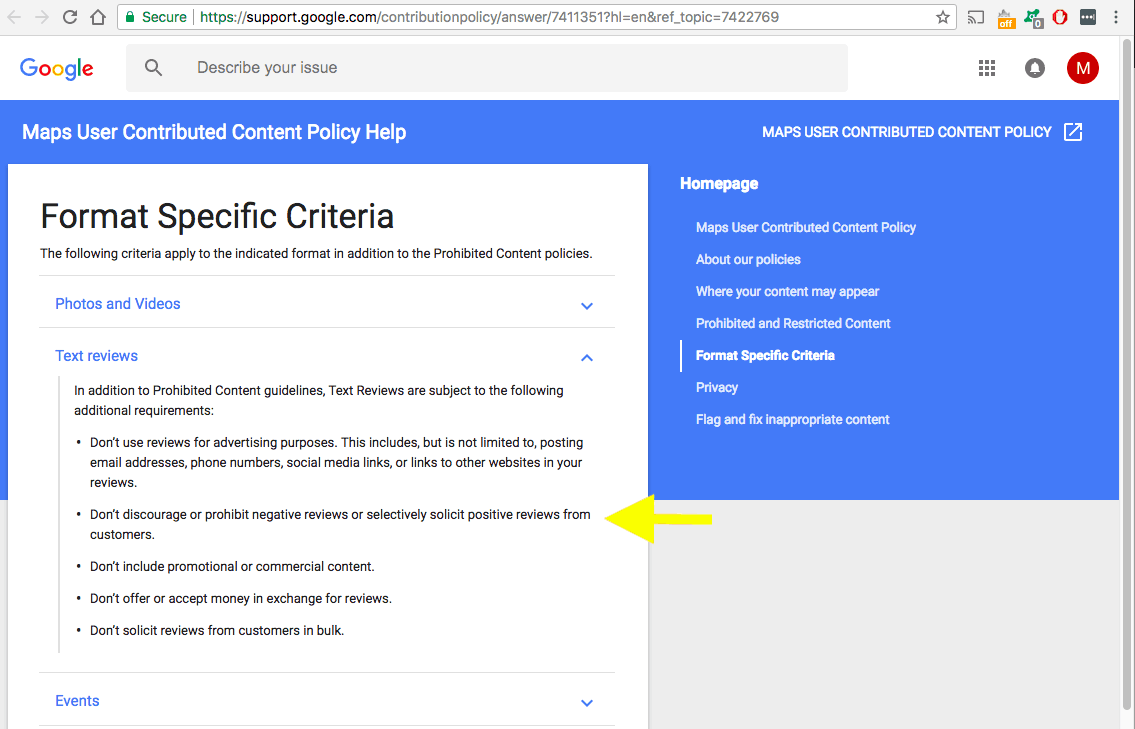In case you missed it, Google recently updated its review policy and added the following requirements: Don’t discourage or prohibit negative reviews or selectively solicit positive reviews from customers. What…
In case you missed it, Google recently updated its review policy and added the following requirements:
Don’t discourage or prohibit negative reviews or selectively solicit positive reviews from customers.
What exactly does this mean for businesses?
The short answer is: you can no longer filter customers before asking them for a review. You can’t choose who you’re going to ask (“selectively solicit”) reviews from. And you can’t discourage customers who had a negative experience from writing reviews of your business.
Of course, as with other requirements included in Google’s policy, these new ones seem open for interpretation, which we’ll be diving into in this blog post. But first: let’s describe what review-gating is, and how it is being applied to practice by marketers hoping to build their business reputation on Google.
What is Review-Gating?
A practice commonly referred to as “review-gating” (or, much more casually, “cherry-picking” reviews), it’s normally done by sending customers a feedback or survey form — be it through email, SMS, landing pages, or social media.
Based on their form responses, customers are then asked to either post a review on Google if they had a positive experience — or share details of their feedback privately if they had a negative experience.
In the context of review generation and reputation management, “review-gating” allows companies to ask the right customers and potential brand promoters for reviews, while isolating those that require follow-up due to their concerns with the customer experience.
While a review site like Yelp explicitly prohibits business owners from proactively requesting reviews from customers, Google is fine with review requests (provided that they are in compliance with policy and content guidelines). This might explain why Google has quickly become the No. 1 website for consumers who want to read or write online reviews of businesses.
According to the 2018 online reviews survey, the search engine giant has outpaced other platforms like Facebook, Yelp, and Tripadvisor in terms of growth in online reviews.
How to Interpret Google’s Review-Gating Policy Requirement
Industry expert Phil Rozek offers several ways to read Google’s “no review-gating” policy:
Interpretation 1: “We don’t care if you only approach happy-ish customers for Google reviews, and we don’t even care exactly how you ask, just as long as you constantly make it clear that customers can leave you a negative review if they feel the need.”
Interpretation 2: “We don’t care who you ask for Google reviews, but you’d better not fixate on their star ratings or what they say in the reviews. So that means don’t be like the hotel that fined guests for leaving bad reviews, don’t tell customers things like, ‘If we haven’t earned your 5-star review yet, please contact us first’, and don’t use review funnels.”
Interpretation 3: “Ask all customers for reviews, or ask none at all. Don’t let your knowledge of a customer’s happiness influence whether you ask him or her for a review. If you do ask for a review, pretend there’s no such thing as a ‘negative’ review, a ‘positive’ review, or star ratings.”
Interpretation 4: “We’re obligated to tell you that you shouldn’t ‘selectively solicit’ or ‘discourage or prohibit’ reviews. We’re smart enough to define those terms more clearly for you, but we’d rather leave it open to interpretation. That’ll deter some people, and it’ll spook software makers into enforcing our policies for us, and it lets us change our definitions however we want.”
No matter how you interpret the new policy requirement, here are some important considerations to make as you look to build up your reviews on Google:
Continue to strive for 5 stars, but don’t try too hard to avoid negative reviews. According to the reviews survey, the average star rating of reviews has increased as consumers today leave more positive reviews. In fact, since 2010, the average review has gotten 12 percent more positive. And the average star rating on Google is 4.3 stars out of 5.
So, while striving for five is always a great mindset to have, it’s even more important to seek (instead of be terrified of) honest, authentic customer feedback.
If you’re surveying your customers and some of them end up saying that their experience was negative, don’t try too hard to suppress their feedback. Let them share their thoughts in their own words and in their own ways; by doing so, you may even be able to benefit from a bad review.
Work with a technology partner to ensure compliance. Here at ReviewTrackers, we are committed to staying up-to-date with industry trends and individual review site policies and content guidelines.
If you’re not quite sure about what is allowed and what isn’t on the sites that you’d like to request reviews for, our team can share in-depth knowledge and best practices to help you stay in compliance and achieve the best possible results for your review generation efforts.
We also rolled out an update to our popular Ask Tool, so that we can continue to deliver a technology solution that is compliant with the policies of today’s top review platforms, as well as responsive to the ever-increasing demand for transparency and authenticity in online reviews.


